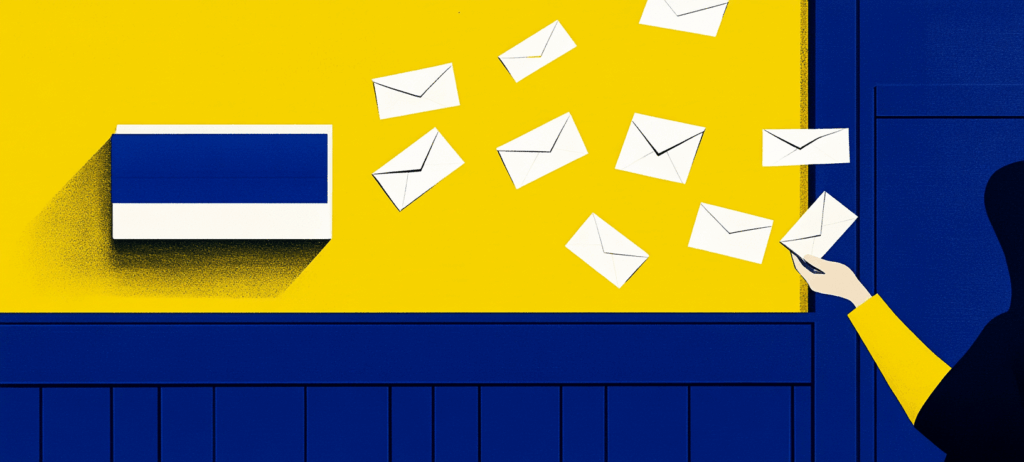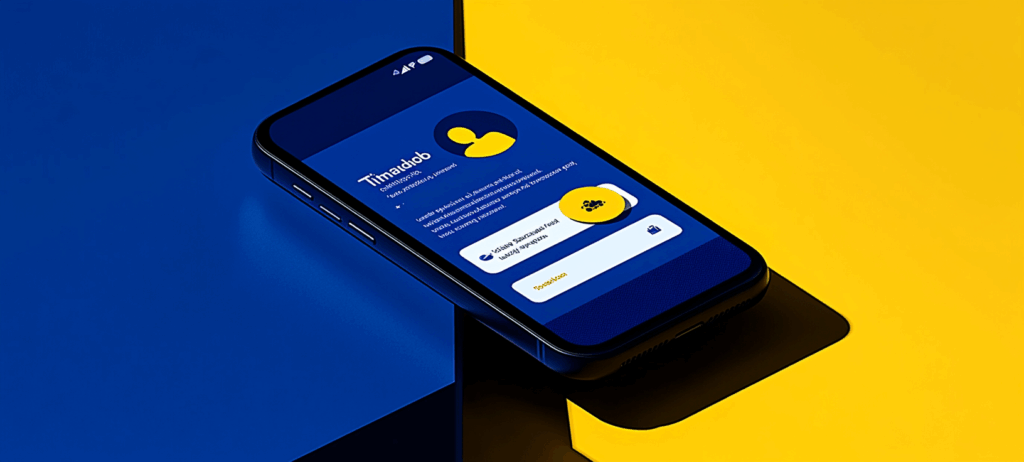-
 Published: Feb 26, 2025
Published: Feb 26, 2025
-
 14 min. read
14 min. read
-
Summarize in ChatGPT
-
 Abby Fields
Abby Fields Digital Marketing Analyst
Digital Marketing Analyst
- Abby is a Digital Marketing Analyst at WebFX, where she implements, optimizes, and tracks SEO and digital marketing strategies that are powered by data for WebFX. With certifications in SEO, Local SEO, and Google Analytics, Abby has implemented hundreds of optimizations and led strategies and initiatives that have helped WebFX improve online visibility, traffic, and leads. Before her time as a Digital Marketing Analyst, Abby was an innovative content writer who created content for WebFX clients in various industries and for WebFX’s own blog and website. When she’s not implementing strategies and optimizations that drive leads and revenue, you’ll find her walking her dog, travelling around Europe, or watching her favorite reality TV show.
Table of Contents
- What is omnichannel marketing?
- How does omnichannel marketing work?
- Omnichannel marketing vs. multichannel marketing: What’s the difference?
- What is omnichannel attribution?
- Benefits of omnichannel marketing
- 5 steps to building an omnichannel marketing strategy
- Examples of omnichannel marketing for inspiration
- Omnichannel marketing FAQ
- Master omnichannel marketing with WebFX
What is omnichannel marketing?
Omnichannel marketing is a strategy that promotes your products and services across multiple channels, devices, and platforms using unified messages that create a consistent brand experience for customers.
If you’re looking for an approach to digital marketing that allows you to harness multiple channels while still maintaining a consistent approach to your campaigns, we can recommend the perfect strategy: Omnichannel marketing.
Its goal is to help you deliver a more effective brand message and a seamless user experience that encourages conversions and sales for your business.
Here’s a quick overview of the topics we’ll cover in this omnichannel guide below:
- What is omnichannel marketing?
- How does omnichannel marketing work?
- Omnichannel marketing vs. multichannel marketing: What’s the difference?
- What is omnichannel attribution?
- Benefits of omnichannel marketing
- 5 steps to building an omnichannel marketing strategy
- Examples of omnichannel marketing for inspiration
- Omnichannel marketing FAQ
So, keep reading to learn more!
And don’t forget to sign up for our newsletter, Revenue Weekly, to join over 200,000 other marketers who get the latest omnichannel and digital marketing advice sent straight to their inbox!
What is omnichannel marketing?
Omnichannel marketing is a strategy that connects all of your marketing channels into one cohesive, efficient system. With an omnichannel marketing strategy, you can reach your customers at each sales funnel stage to drive more conversions and sales for your company.
How does omnichannel marketing work?
Now that you know the answer to the question “what is omnichannel marketing”, let’s answer another burning question: “how does omnichannel marketing work?
To understand how it works, it’s essential to first understand the sales funnel and customer journey.
In most cases, customers don’t immediately decide to purchase your products or services. They typically interact with your business multiple times before they become a customer.
For example, a customer might have first discovered your brand on social media and then decided to read one of your blog posts. A few weeks later, they choose to sign up for your emails and eventually purchase one of your products.
With the omnichannel experience, you can create compelling marketing messages that target users in each touchpoint and interaction mentioned above. As a result, you can make more personalized messages that target users in specific stages of your sales funnel to encourage more users to convert into paying customers.
Omnichannel marketing vs. multichannel marketing: What’s the difference?
Omnichannel and multichannel marketing seem like two very similar terms, and it can be easy to confuse them. While both strategies target your audience across multiple channels, the terms aren’t interchangeable.
Luckily, we’ve got just the breakdown for you to discuss some of the key differences between the two. Check out the major differences between omnichannel marketing vs. multichannel marketing below:
Multichannel marketing
Multichannel marketing is the simpler of the two marketing strategies. With a multichannel marketing strategy, you can promote your products and services across multiple channels, but these channels aren’t connected.
In other words, you might have a website, blog, and social media page in which users can interact with your brand. However, because the channels aren’t connected, users won’t see consistent messages or have a seamless experience that enables them to easily switch between channels.
Omnichannel marketing
Omnichannel marketing connects your marketing channels into one efficient and seamless experience. As a result, users can interact with your business across multiple channels, like your social media page and website, and still see content that’s relevant to them at their stage in the sales funnel.
By implementing an omnichannel experience, you can encourage users to move down your sales funnel even when they switch between channels.
What is omnichannel attribution?
Omnichannel attribution is the process of tracking customer interactions across multiple channels in an omnichannel campaign and crediting each of those interactions for any resulting leads or conversions.
Let’s break that down just a bit more. When you drive leads or conversions with your marketing, it’s helpful to know how you drove them. Which marketing channels or campaigns contributed to those results? The answer helps you identify which channels are the most valuable to you.
That’s where attribution comes in. And in an omnichannel context, it’s helpful to track interactions across all the channels in a given campaign. That allows you to pinpoint the strongest and weakest areas of your omnichannel strategy.
Benefits of omnichannel marketing
So, why is omnichannel marketing essential, and how can it help your business grow? We’ve got the answers for you!
Here are some of the biggest benefits of omnichannel marketing:
- It creates more personalized experiences: Omnichannel marketing allows you to customize your campaigns more to specific users. For example, you could send someone a personalized email based on the pages they viewed on your website.
- It encourages more conversions and sales: When users get the same messaging across multiple platforms, it makes them more likely to become leads or customers. That results in more sales and revenue for your business.
- It helps you earn a higher return on investment (ROI): Omnichannel marketing is more efficient than multichannel marketing, because the costs stay the same, but the conversion rate goes up. That means you get a higher ROI overall.
- It delivers more consistent branding: Omnichannel marketing gives your campaigns a clearer focus and direction, with all your different channels sending the same messaging. That gives your brand more consistency, which helps it stick more firmly in users’ minds.
- It reaches a wider audience: Since omnichannel marketing takes place across a variety of channels at once, it allows you to reach a much larger audience than you’d be able to reach if you confined your campaigns to a single channel.
Ultimately, omnichannel marketing can majorly boost the success of your company’s campaigns.
5 steps to building an omnichannel marketing strategy
Want to leverage omnichannel marketing in your strategy? Here are five steps to building an omnichannel strategy that drives conversions:
- Learn about your audience
- Identify the right channels for you
- Generate personalized content
- Un-silo your departments
- Monitor your results
1. Learn about your audience
The basis of any successful marketing campaign is knowing your audience. To have a successful omnichannel marketing campaign, you must know your consumers and how they experience your channels as a whole.
Have your customer in mind when you create an omnichannel campaign. It’s the most effective way to optimize your campaigns for customer experience. Ask yourself: “What options and products would you (as a customer) want to see across all your channels?”
Stepping into your buyer’s shoes helps you increase your buyer’s experience throughout your channels. Here are some steps you can take to learn more about your customer base:
- Gather feedback and reviews. After your consumers make a purchase, invite them to give feedback and reviews. By asking for feedback, you can more easily discover faults within your products and services. You can then steadily work on improving those faults.
- Use social listening tools. Social listening tools like Hootsuite can help you find the trends that your buyers are talking about. They can also help you find mentions of your brand to see what people think of it.
- Create buyer personas. Use the data you collect to segment your audience into personas. Having a clear understanding of the similar traits between your buyers helps you determine what kind of experience they want to have. By analyzing your audience, your content, products, and services will be relevant to your buyers.
2. Identify the right channels for you
Omnichannel marketing is all about using multiple channels for your campaigns, but the question is, which channels should you use? The answer to that depends entirely on your business and its unique needs.
Start by taking a look at the audience data you gathered in the previous step. What does that data tell you? Which channels do your audience interact with the most?
Then consider your unique branding. Which channels best lend themselves to the type of marketing campaigns you run? What channels have worked the best for you in the past?
By gathering answers to each of these questions, you can get a good picture of which channels are ideal for your business. Then it’s a matter of crafting campaigns that reach across all of those different channels.
3. Generate personalized content
Generating content for each of your channels has value because your content is what your consumers will be interacting with the most.
The best way to use content in your omnichannel campaign is to personalize it, which means incorporating the data you collected about your customers into your process for generating content, either manually, or most likely, through an automated process.
Your content must target your customer lists. The data you collect will tell you:
- When they sign up for your email newsletters, which you can use to send your users welcome deals and similar content to the first piece they viewed.
- When they search or purchase a product or service, which you can use to send them deals for similar products and services.
- When they search to solve a problem, which you can use to send them products or services that could help them solve it.
It will also tell you any information you gather about your buyers’ demographics. Send your buyers information on:
- Events occurring in their location
- Seasonal events applicable to their area
- Products and services, trends, and topics similar to their previous interests
- Products and services, trends, and topics their peers are interested in
To successfully implement omnichannel marketing, you need to work out how to make your content relevant exactly when your consumers need it. This means thoroughly testing your content to see what works and what doesn’t.
Your consumers will be much more likely to convert when they get the content they want it.
4. Un-silo your departments
The most important, and perhaps the most challenging part of omnichannel strategies is to get your departments to work together, which requires redefining and reorganizing your teams. Start by:
- Having a central hub, a single platform for both front-end and back-end, to manage all of your channels.
- Scheduling regular meetings to teach each of your departments on how to interact with each other and to generate new ideas on how to improve your consumers’ buying process.
For omnichannel marketing to work, all of your departments must be able to have a hand in customer experience. For example, when your technical department has fluid communication with your marketing department, it’s easier to test your advertising campaigns to find what creates the most leads.
When you do this, you’ll maximize the value of your existing digital systems. With an interconnected channel approach, you’ll have more opportunities for automation to be implemented effectively because you’ll have less redundant automated and manual tasks since one task will affect the whole network.
In other words, omnichannel marketing helps you reduce system and departmental complexities and streamline your workflow.
5. Monitor your results
No marketing campaign is complete without data analytics. If you don’t monitor how your campaigns are performing, you’ll have no idea what changes you need to make. For that reason, be sure to track detailed performance data for all of the channels in your omnichannel marketing.
There are lots of tools you can use to do this, from general marketing software to customer relationship management (CRM) platforms to free Google tools like Google Analytics. Whichever tools you use, though, you’ll want to centralize all your data in one location where it can be easily viewed and analyzed as a whole, and where everyone at your business can access it (going back to the un-siloing step).
Examples of omnichannel marketing for inspiration
Are you ready to implement an omnichannel experience but need some inspiration? We’ve got you covered.
Check out our favorite examples of omnichannel marketing below:
1. Starbucks
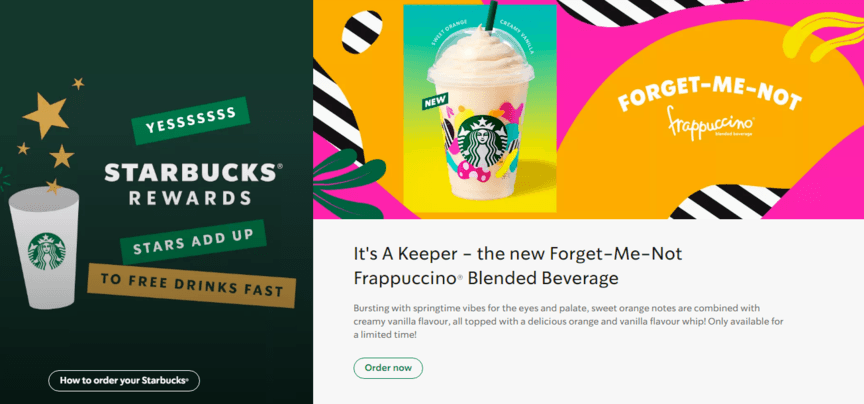
Starbucks is one of the top omnichannel experiences out there, making it possible for customers to interact with the brand no matter where they are in the world.
Why it works
Customers can visit their physical locations all around the globe, and they can also interact with the brand on the Starbucks app, website, social media page, and more.
Plus, Starbucks offers a customer loyalty program that enables you to earn free rewards whenever you make a purchase. In addition, you can top up your loyalty card by phone, on the website, or in-store.
2. Spotify
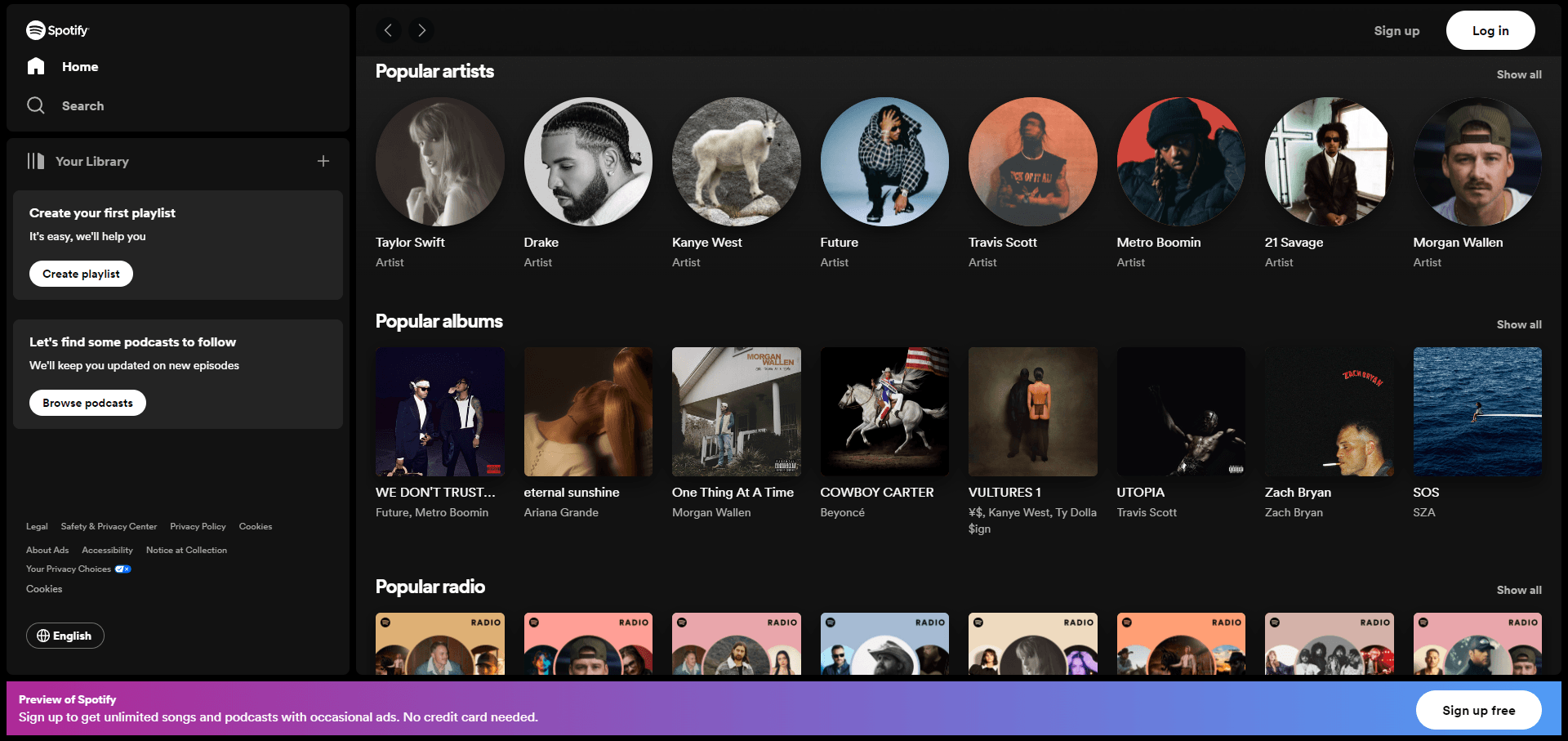
If there’s one company that really has omnichannel marketing nailed down, it’s Spotify. This music streaming company excels at engaging users across a variety of platforms. Not only does it use omnichannel marketing to reach new prospects, but it also harnesses it to keep existing users engaged.
Why it works
For its existing users, Spotify offers multiple ways to access the platform. You can play music on their website, their desktop app, or their mobile app. In fact, if you have them all open at the same time, they’ll all sync together.
In terms of marketing to new prospects, Spotify also takes an omnichannel approach. They sometimes run ads on streaming services like Hulu. And each year, when they send users a “Spotify Wrapped” report of the music they listened to that year, people flock to social media to share their results. It’s the perfect user-generated marketing campaign.
3. Disney
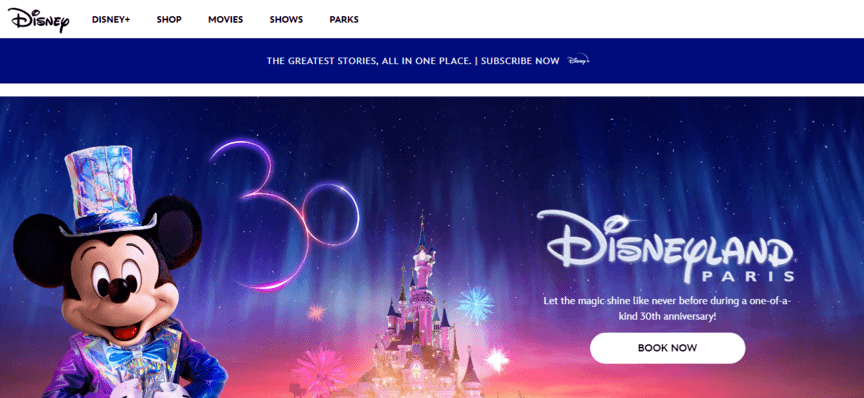
Last on our examples of omnichannel marketing is Disney. Next to their main website, Disney offers a wide range of channels in which users can interact with the brand.
Why it works
From investing in sponsored advertisements on social media, offering multiple resources to manage your trip to Disney parks, to providing its own streaming or OTT platform, Disney targets users across multiple platforms and channels.
4. Walgreens
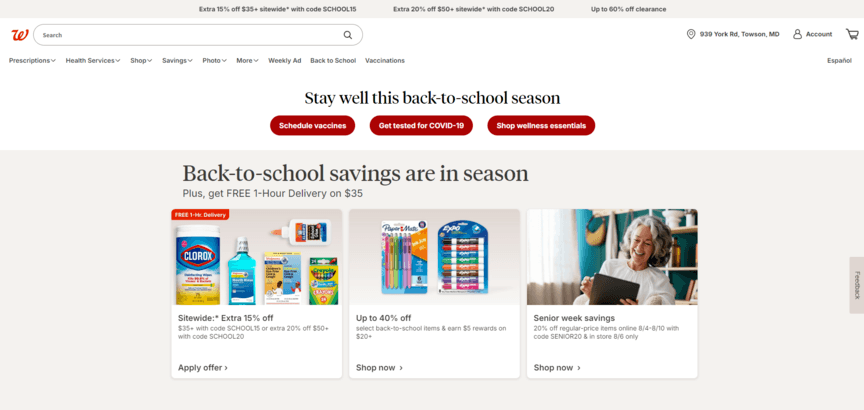
Walgreens makes a point of giving their customers multiple avenues to receive marketing materials and order medications, making for an effective omnichannel experience.
Why it works
One way to receive medications from Walgreens is to go in person, while another is to call over the phone. Still another option is to use the Walgreens website or app, which will also let you check the status of your prescriptions. Plus, Walgreens likes to send out emails (both for marketing purposes and for prescription notifications).
5. Amazon
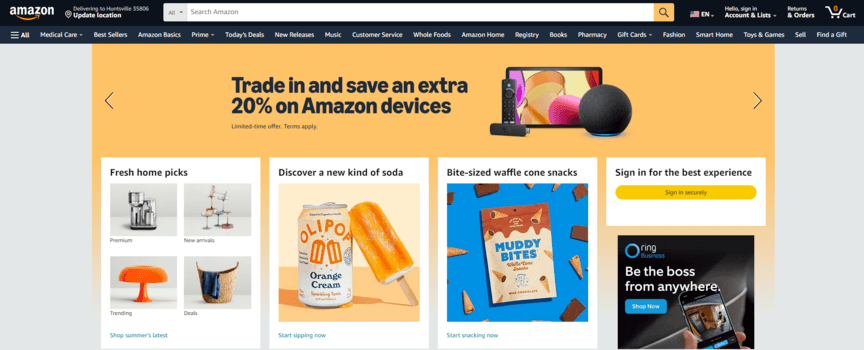
Amazon really goes all the way with its omnichannel marketing, offering numerous different channels for purchasing products that are all closely synced and interconnected. That makes it easy for users to jump between different platforms over the course of a single purchase.
Why it works
Amazon’s main channel is their website, of course. But they also have an app, and it syncs users’ carts with the website so that they can easily jump between the two. They even have physical storefronts where users can grab products in person but still pay through the app. It’s all one streamlined experience.
Omnichannel marketing FAQ
Learn the answers to some common omnichannel marketing questions below:
What is omnichannel marketing?
Omnichannel marketing is a strategy that promotes your products and services across multiple channels, devices, and platforms. It does this using unified messages that create a consistent brand experience for your customers.
Why is omnichannel marketing good?
Omnichannel marketing is good for businesses because it helps you reach a wider audience. Not everyone in your audience will use every channel that you market on, so to reach them all, you need your campaigns to span all your different channels. Omnichannel campaigns are also more personalized and consistent with their branding.
Is omnichannel the same as multichannel?
Omnichannel and multichannel marketing are related, but not the same thing. Multichannel marketing is simply a type of marketing where you run campaigns on multiple channels. But with omnichannel marketing, those campaigns are all connected. Omnichannel campaigns use the same branding message across all channels.
What is an example of omnichannel marketing?
An example of omnichannel marketing might be the following:
Someone is on social media when they see a post from your business promoting a sale on one of your products. Later, that person receives an email from you that promotes the same sale. When they finally visit your website, they see a banner on your homepage that encourages them to take advantage of the sale.
That’s an example of omnichannel marketing because it’s all one marketing campaign with one consistent message, but it’s taking place over multiple channels at once.
Our digital marketing campaigns impact the metrics that improve your bottom line.
See Our Approach
$10 billion

24 million

7.14 million
Master omnichannel marketing with WebFX
Are you finding it tricky to wrap your head around omnichannel marketing? Do you struggle to find the time to manage an omnichannel marketing strategy for your business? WebFX can help!
WebFX is a top digital marketing agency with more than 29 years of experience implementing and managing revenue-driving marketing strategies for businesses just like yours.
Our team can help you map your customer’s journeys to develop strategies that target users in each stage of your sales funnel so you can drive more revenue for your company.
If you’re ready to partner with a leading agency behind over $10 billion in revenue, call us at 888-601-5359 or contact us online to learn more about our digital marketing services! We can’t wait to help your business grow!
-
 Abby is a Digital Marketing Analyst at WebFX, where she implements, optimizes, and tracks SEO and digital marketing strategies that are powered by data for WebFX. With certifications in SEO, Local SEO, and Google Analytics, Abby has implemented hundreds of optimizations and led strategies and initiatives that have helped WebFX improve online visibility, traffic, and leads. Before her time as a Digital Marketing Analyst, Abby was an innovative content writer who created content for WebFX clients in various industries and for WebFX’s own blog and website. When she’s not implementing strategies and optimizations that drive leads and revenue, you’ll find her walking her dog, travelling around Europe, or watching her favorite reality TV show.
Abby is a Digital Marketing Analyst at WebFX, where she implements, optimizes, and tracks SEO and digital marketing strategies that are powered by data for WebFX. With certifications in SEO, Local SEO, and Google Analytics, Abby has implemented hundreds of optimizations and led strategies and initiatives that have helped WebFX improve online visibility, traffic, and leads. Before her time as a Digital Marketing Analyst, Abby was an innovative content writer who created content for WebFX clients in various industries and for WebFX’s own blog and website. When she’s not implementing strategies and optimizations that drive leads and revenue, you’ll find her walking her dog, travelling around Europe, or watching her favorite reality TV show. -

WebFX is a full-service marketing agency with 1,100+ client reviews and a 4.9-star rating on Clutch! Find out how our expert team and revenue-accelerating tech can drive results for you! Learn more
Try our free Marketing Calculator
Craft a tailored online marketing strategy! Utilize our free Internet marketing calculator for a custom plan based on your location, reach, timeframe, and budget.
Plan Your Marketing Budget
Table of Contents
- What is omnichannel marketing?
- How does omnichannel marketing work?
- Omnichannel marketing vs. multichannel marketing: What’s the difference?
- What is omnichannel attribution?
- Benefits of omnichannel marketing
- 5 steps to building an omnichannel marketing strategy
- Examples of omnichannel marketing for inspiration
- Omnichannel marketing FAQ
- Master omnichannel marketing with WebFX

Proven Marketing Strategies

Proven Marketing Strategies
Try our free Marketing Calculator
Craft a tailored online marketing strategy! Utilize our free Internet marketing calculator for a custom plan based on your location, reach, timeframe, and budget.
Plan Your Marketing Budget
What to read next

